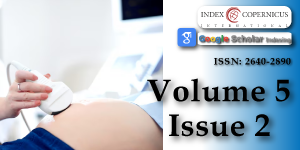Impact of various PCOS phenotypes on oocyte competence in an ART cycle
Main Article Content
Abstract
Introduction: PCOS is a common cause of female infertility. Although PCOS patients are characterized by producing an increased number of oocytes, they are often of poor quality, leading to lower fertilization, cleavage, and implantation and higher miscarriage rates.
Aims: The present study aims to identify the effect of various PCOS phenotypes on oocyte competence in an ART cycle.
Settings and design: A retrospective observational study.
Methods and material: The study group included 102 women with PCOS as a main cause of infertility. Data was collected over a period of one year (2017-18). These women were divided into four groups on basis of PCOS phenotypes (A-D) and the relevant clinical data and the ART outcome were noted. Statistical analysis was done using SPSS statistical package. Data presented as mean ± SD which was compared using the ANOVA test. A p - value < 0.05 was considered statistically significant.
Results: Out of 102 PCOS women, 23.52% women had phenotype A, 11.76% had phenotype B, and 45.09% and 19.60% had phenotype C & D respectively. Good quality embryos formed (p - value 0.01) were lower in Group B vs. other groups. However, clinical pregnancy rates were comparable in all groups.
Conclusion: The reproductive potential of women with PCOS varies with the oocyte health and it largely depends on PCOS phenotype. Women with PCOS phenotype B might have poor IVF/ICSI outcomes with regard to the number of oocytes retrieved and embryos formed. PCO morphology might carry an advantage with regards to the number of oocytes retrieved and better quality embryos. It seems that hyperandrogenism in combination with chronic anovulation is associated with poor oocyte competence and hence, a negative impact on embryo quality and clinical pregnancy rate. Further studies with a larger sample size are required to further support it.
Key messages: Oocyte competence in various PCOS phenotypes.
Article Details
Copyright (c) 2022 Jain N, et al.

This work is licensed under a Creative Commons Attribution 4.0 International License.
Choi MH, Lee SH, Kim HO, Cha SH, Kim JY, Yang KM, Song IO, Koong MK, Kang IS, Park CW. Comparison of assisted reproductive technology outcomes in infertile women with polycystic ovary syndrome: In vitro maturation, GnRH agonist, and GnRH antagonist cycles. Clin Exp Reprod Med. 2012 Dec;39(4):166-71. doi: 10.5653/cerm.2012.39.4.166. Epub 2012 Dec 31. PMID: 23346527; PMCID: PMC3548075.
Rotterdam ESHRE/ASRM-Sponsored PCOS Consensus Workshop Group. Revised 2003 consensus on diagnostic criteria and long-term health risks related to polycystic ovary syndrome. Fertil Steril. 2004 Jan;81(1):19-25. doi: 10.1016/j.fertnstert.2003.10.004. PMID: 14711538.
Azziz R. Determinants of the polycystic ovarian syndrome. Fertil Steril. 2016; 106:0015-0282.
Lizneva D, Kirubakaran R, Mykhalchenko K, Suturina L, Chernukha G, Diamond MP, Azziz R. Phenotypes and body mass in women with polycystic ovary syndrome identified in referral versus unselected populations: systematic review and meta-analysis. Fertil Steril. 2016 Nov;106(6):1510-1520.e2. doi: 10.1016/j.fertnstert.2016.07.1121. Epub 2016 Aug 13. PMID: 27530062.
De Vos M, Pareyn S, Drakopoulos P, Raimundo JM, Anckaert E, Santos-Ribeiro S, Polyzos NP, Tournaye H, Blockeel C. Cumulative live birth rates after IVF in patients with polycystic ovaries: phenotype matters. Reprod Biomed Online. 2018 Aug;37(2):163-171. doi: 10.1016/j.rbmo.2018.05.003. Epub 2018 May 7. PMID: 29778554.
Fisch JD, Keskintepe L, Sher G. Gonadotropin-releasing hormone agonist/antagonist conversion with estrogen priming in low responders with prior in vitro fertilization failure. Fertil Steril. 2008 Feb;89(2):342-7. doi: 10.1016/j.fertnstert.2007.03.004. Epub 2007 Jun 11. PMID: 17562336.
Gleicher N, Weghofer A, Barad DH. The role of androgens in follicle maturation and ovulation induction: friend or foe of infertility treatment? Reprod Biol Endocrinol. 2011 Aug 17;9:116. doi: 10.1186/1477-7827-9-116. PMID: 21849061; PMCID: PMC3170254.
Ramezanali F, Ashrafi M, Hemat M, Arabipoor A, Jalali S, Moini A. Assisted reproductive outcomes in women with different polycystic ovary syndrome phenotypes: the predictive value of anti-Müllerian hormone. Reprod Biomed Online. 2016 May;32(5):503-12. doi: 10.1016/j.rbmo.2016.01.010. Epub 2016 Feb 2. PMID: 26968928.
Kar S. Anthropometric, clinical, and metabolic comparisons of the four Rotterdam PCOS phenotypes: A prospective study of PCOS women. J Hum Reprod Sci. 2013 Jul;6(3):194-200. doi: 10.4103/0974-1208.121422. PMID: 24347934; PMCID: PMC3853876.
Sigala J, Sifer C, Dewailly D, Robin G, Bruyneel A, Ramdane N, Lefebvre-Khalil V, Mitchell V, Decanter C. Is polycystic ovarian morphology related to a poor oocyte quality after controlled ovarian hyperstimulation for intracytoplasmic sperm injection? Results from a prospective, comparative study. Fertil Steril. 2015 Jan;103(1):112-8. doi: 10.1016/j.fertnstert.2014.09.040. Epub 2014 Oct 25. PMID: 25450303.
Sun B, Wang F, Sun J, Yu W, Sun Y. Basal serum testosterone levels correlate with ovarian response but do not predict pregnancy outcome in non-PCOS women undergoing IVF. J Assist Reprod Genet. 2014 Jul;31(7):829-35. doi: 10.1007/s10815-014-0246-8. Epub 2014 May 22. PMID: 24849376; PMCID: PMC4096887.

